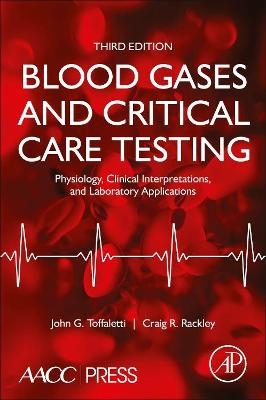
Blood Gases and Critical Care Testing
Academic Press Inc (Verlag)
978-0-323-89971-0 (ISBN)
The third edition of this classic book is a complete revision and provides the fundamentals of blood gas (pH, pCO2, pO2) and other critical care tests (calcium, magnesium, phosphate, and lactate), including the history, the definitions, the physiology, and practical information on sample handling, quality control and reference intervals. Case examples with clear clinical interpretations of critical care tests have been included to all chapters.
This book will serve as a valuable and convenient resource for clinical laboratory scientists in understanding the physiology and clinical use of these critical care tests and for providing practical guidelines for successful routine testing and quality monitoring of these tests.
John G. Toffaletti received a BS from the University of Florida in Gainesville and followed this with training in clinical chemistry at the University of North Carolina at Chapel Hill, where he earned a PhD in Biochemistry, then completed a Postdoctoral Fellowship in Clinical Chemistry at Hartford Hospital. Since completing these programs, he has worked in the Clinical Laboratories at Duke University Medical Center since 1979, where he is now Professor of Pathology, Director of the Blood Gas Laboratory, the Clinical Pediatric Laboratory, and several Outpatient Laboratories. He is also the Chief of Clinical Chemistry at the Durham VA Medical Center. He has written or presented numerous workshops, books, study guides, chapters, and seminars on the interpretation of blood gas, cooximetry, ionized calcium, magnesium, lactate (sepsis), kidney function tests (creatinine, cystatin C, GFR), and viscoelastic testing (ROTEM and TEG). His research interests include sample collection, pre-analytical errors, analysis, and clinical use of these tests. Dr. Craig R. Rackley specializes in pulmonary disease in Durham, North Carolina, and has over 18 years of experience in the field of medicine. He graduated from Georgetown University of Medicine with his medical degree in 2002 and is affiliated with numerous hospitals in North Carolina, including Duke University Medical Center, USA.
1. Introduction to Blood Gases and Blood Gas Physiology
2. Physiologic Mechanisms and Diagnostic Approach to Acid-Base Disorders
3. Interpreting Blood Gas Results on Venous, Capillary, and Umbilical Cord Blood
4. Disorders of Oxygenation: Hypoxemia and Tissue Hypoxia
5. Calcium Physiology and Diagnostic Evaluation
6. Magnesium Physiology and Diagnostic Evaluation
7. Phosphate Physiology and Diagnostic Evaluation
8. Osmolality, Sodium, Potassium, Chloride, and Bicarbonate Osmolality and Volume Regulation
9. Lactate Physiology and Diagnostic Evaluation
10. Collection and Handling of Samples: Effects on Blood Gases and Electrolytes: Na, K, Ionized Ca, Mg, Lactate, Phosphate Analysis
11. Quality Control in Blood Gas and Critical Care Testing
12. Models for Point of Care Testing for Critical Care Analytes
| Erscheinungsdatum | 14.10.2021 |
|---|---|
| Zusatzinfo | 30 illustrations (20 in full color); Illustrations |
| Verlagsort | Oxford |
| Sprache | englisch |
| Maße | 152 x 229 mm |
| Gewicht | 450 g |
| Themenwelt | Naturwissenschaften ► Biologie |
| ISBN-10 | 0-323-89971-4 / 0323899714 |
| ISBN-13 | 978-0-323-89971-0 / 9780323899710 |
| Zustand | Neuware |
| Haben Sie eine Frage zum Produkt? |
aus dem Bereich


